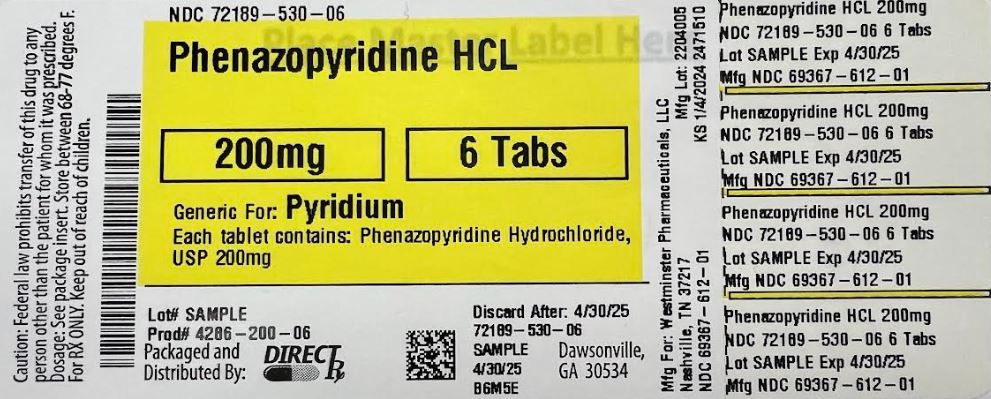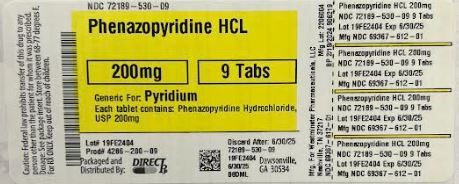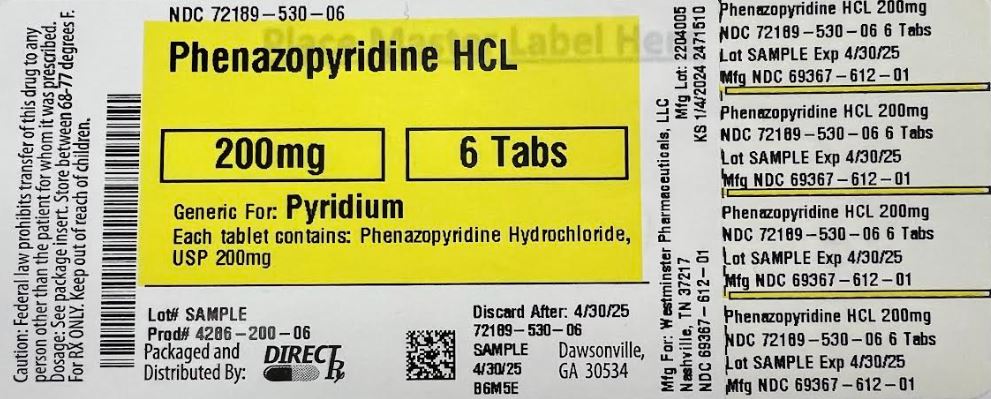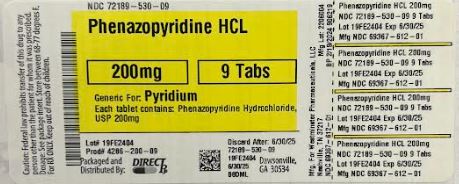Label: PHENAZOPYRIDINE HCL tablet
- NDC Code(s): 72189-530-06, 72189-530-09
- Packager: Direct Rx
- This is a repackaged label.
- Source NDC Code(s): 69367-612
- Category: HUMAN PRESCRIPTION DRUG LABEL
- DEA Schedule: None
- Marketing Status: unapproved drug other
DISCLAIMER: This drug has not been found by FDA to be safe and effective, and this labeling has not been approved by FDA. For further information about unapproved drugs, click here.
Drug Label Information
Updated February 19, 2024
If you are a consumer or patient please visit this version.
- Download DRUG LABEL INFO: PDF XML
- Official Label (Printer Friendly)
- SPL UNCLASSIFIED SECTION
-
DESCRIPTION
Phenazopyridine Hydrochloride is a reddish-brown, odorless, slightly bitter, crystalline powder. It has a specific local analgesic effect in the urinary tract, promptly relieving burning and pain.
Following is the structural formula:
[Chemical Structure]
C11H11N5 ∙ HCl M.W. 249.70
Phenazopyridine Hydrochloride oral tablets contain the following inactive ingredients: Croscarmellose Sodium, D&C Yellow #10 Aluminum Lake, FD&C Blue #1 Aluminum Lake, FD&C Red #40 Aluminum Lake, FD&C Yellow #6 Aluminum Lake, Magnesium Stearate, Microcrystalline Cellulose, Polyethylene Glycol, Polyvinyl Alcohol, Povidone, Pregelatinized Starch, Talc, and Titanium Dioxide.
-
CLINICAL PHARMACOLOGY
Phenazopyridine hydrochloride is excreted in the urine where it exerts a topical analgesic effect on the mucosa of the urinary tract. This action helps to relieve pain, burning, urgency and frequency. The precise mechanism of action is unknown.
PHARMACOKINETICS
The pharmacokinetic properties of Phenazopyridine hydrochloride have not been determined. Phenazopyridine Hydrochloride and its metabolites are rapidly excreted by the kidneys. In a small number of healthy subjects, 90% of a 600 mg/day oral dose of Phenazopyridine hydrochloride was eliminated in the urine in 24 hours, 41% as unchanged drug and 49% as metabolites.
-
INDICATIONS & USAGE
Phenazopyridine Hydrochloride is indicated for the symptomatic relief of pain, burning, urgency frequency, and other discomforts arising from irritation of the mucosa of the lower urinary tract caused by infection, trauma, surgery, endoscopic procedures, or the passage of sounds or catheters.
The use of Phenazopyridine Hydrochloride for relief of symptoms should not delay definitive diagnosis and treatment of causative conditions. The drug should be used for symptomatic relief of pain and not as a substitute for specific surgery or antimicrobial therapy.
Phenazopyridine Hydrochloride is compatible with antimicrobial therapy and can help relieve pain and discomfort during the interval before antimicrobial therapy controls the infection.
Treatment of a urinary tract infection with Phenazopyridine Hydrochloride should not exceed 2 days. There is no evidence that the combined administration of Phenazopyridine Hydrochloride and an antimicrobial provides greater benefit than administration of the antimicrobial alone after 2 days. (See DOSAGE AND ADMINISTRATION.)
-
CONTRAINDICATIONS
Phenazopyridine Hydrochloride should not be used in patients who are hypersensitive to the drug or its ingredients. Phenazopyridine Hydrochloride is contraindicated in patients with renal insufficiency, severe liver disease, severe hepatitis or pyelonephritis of pregnancy. It should be used cautiously in the presence of GI disturbances.
-
WARNINGS
Phenazopyridine Hydrochloride is reasonably anticipated to be a human carcinogen based on sufficient evidence of carcinogenicity in experimental animals (IARC 1980, 1982, 1987, NCI 1978). When administered in the diet, Phenazopyridine hydrochloride increased the incidences of hepatocellular adenomas and carcinomas in female mice and adenomas and adenocarcinomas of the colon and rectum in rats of both sexes. There is inadequate evidence for the carcinogenicity of Phenazopyridine hydrochloride in humans (TARC 1987). In one limited epidemiological study, no significant excess of any cancer was observed among 2,214 patients who received Phenazopyridine hydrochloride and were followed for a minimum of 3 years.
-
PRECAUTIONS
General
The patient should be advised that Phenazopyridine Hydrochloride produces an orange to red color in the urine and feces, and may cause staining. Phenazopyridine Hydrochloride may cause discoloration of body fluids and staining of contact lenses has been reported. A yellowish color of the skin or sclera may indicate accumulation of Phenazopyridine Hydrochloride resulting from impaired renal function and necessitates discontinuance of the drug. It should be noted that a decline in renal function is common in elderly patients. Phenazopyridine Hydrochloride may mask pathological conditions and interfere with laboratory test values using colorimetric, spectrophotometric or fluorometric analysis methods.
Cautious use in patients with G-6-PD deficiency is advised since these patients are susceptible to oxidative hemolysis and may have greater potential to develop hemolytic anemia.
Information for Patients
The patient should be advised to take Phenazopyridine Hydrochloride with or following food or after eating a snack to reduce stomach upset.
The patients should be aware that Phenazopyridine Hydrochloride causes a reddish orange discoloration of the urine and feces, and may stain clothing. Phenazopyridine Hydrochloride may cause discoloration of body fluids and staining of contact lenses has been reported. There have been reports of teeth discoloration when the product has been broken or held in the mouth prior to swallowing.
Patients should be instructed to take Phenazopyridine Hydrochloride for only 2 days if an antibacterial agent is administered concurrently for the treatment of a urinary tract infection.
If symptoms persist beyond those 2 days, the patient should be instructed to contact his or her physician.
Laboratory Tests
Phenazopyridine Hydrochloride may interfere with laboratory test values using colorimetric, photometric or fluorometric analysis methods.
Altered urine laboratory test values may include ketone (sodium nitroprusside) bilirubin (foam test, talc-disk-Fouchet-spot test, Franklin's tablet-Fouchet test, p-nitrobenzene diazonium p-toluene sulfonate reagent), diacetic acid (Gerhardt ferric chloride test), free hydrochloric acid, glucose (glucose oxidase tests), 17-hydroxycorticosteroids (modified Glenn-Nelson), 17-ketosteroids (Holtorff Koch modification of Zimmerman), porphyrins, albumin (discolors bromophenol blue test areas of commercial reagent strips, nitric acid ring test), phenolsulfophthalein, urobilinogen (color interference with Ehrlich's reagent), and urinalysis (spectrophotometric or color-based tests). Phenazopyridine Hydrochloride also imparts an orange-red color to stools which may interfere with color tests.
Drug Interactions
The interaction of Phenazopyridine Hydrochloride with other drugs has not been studied in a systematic manner. However, the medical literature to date suggests that no significant interactions have been reported.
Carcinogenesis, Mutagenesis, Impairment of Fertility
Long-term administration of Phenazopyridine Hydrochloride has been associated with tumors of the large intestine in rats and of the liver in mice. Available epidemiological data are insufficient to evaluate the carcinogenicity of Phenazopyridine Hydrochloride in humans. In vitro studies indicate that Phenazopyridine Hydrochloride in the presence of metabolic activation is mutagenic in bacteria and mutagenic and clastogenic in mammalian cells.
Pregnancy Category B
Reproductive studies with Phenazopyridine Hydrochloride (in combination with sulfacytine) in rats given up to 110 mg/kg/day and in rabbits given up to 39 mg/kg/day during organogenesis revealed no evidence of harm to offspring.
One prospective study in humans demonstrated that Phenazopyridine Hydrochloride traverses the placenta into the fetal compartment. There are no adequate and well-controlled studies in pregnant women. Therefore, Phenazopyridine Hydrochloride should be used in pregnant women only if the benefit clearly outweighs the risk.
Nursing Mothers
It is not known whether Phenazopyridine Hydrochloride or its metabolites are excreted in human milk. Because many drugs are excreted in human milk, a decision should be made to discontinue nursing or to discontinue the drug, taking into account the importance of drug therapy to the mother.
Children
Adequate and well-controlled studies have not been performed in the pediatric population. No pediatric-specific problems have been documented.
-
DOSAGE & ADMINISTRATION
100 mg Tablets: Average adult dosage is two tablets 3 times a day after meals.
200 mg Tablets: Average adult dosage is one tablet 3 times a day after meals.When used concomitantly with an antibacterial agent for the treatment of a urinary tract infection, the administration of Phenazopyridine Hydrochloride should not exceed 2 days.
-
ADVERSE REACTIONS
The following adverse events have been reported:
CNS: headache.
Gastrointestinal: nausea, vomiting and diarrhea.
Dermatologic and Hypersensitivity: rash, pruritus, discoloration, anaphylactoid-like reaction and hypersensitivity hepatitis.
Hematologic: methemoglobinemia, hemolytic anemia, potential hemolytic agent in G-6-PD deficiency, sulfhemoglobinemia.
Other: visual disturbances, renal and hepatic toxicity usually associated with overdose, renal calculi, jaundice, discoloration of body fluids and aseptic meningitis.
-
HOW SUPPLIED
100 mg Tablets: Supplied in bottles of 100ct (NDC 69367-611-01)
Appearance: Dark brown coated, round standard cup tablet, debossed "611" on one side and plain on the other.200 mg Tablets: Supplied in bottles of 6ct (NDC 72189-530-06)
Appearance: Dark brown coated, round standard cup tablet, debossed "612" on one side and plain on the other.DISPENSE contents with a child-resistant closure (as required) and in a tight container as defined in the USP.
- SPL UNCLASSIFIED SECTION
- STORAGE AND HANDLING
- PRINCIPAL DISPLAY PANEL
- PRINCIPAL DISPLAY PANEL
-
INGREDIENTS AND APPEARANCE
PHENAZOPYRIDINE HCL
phenazopyridine hcl tabletProduct Information Product Type HUMAN PRESCRIPTION DRUG Item Code (Source) NDC:72189-530(NDC:69367-612) Route of Administration ORAL Active Ingredient/Active Moiety Ingredient Name Basis of Strength Strength PHENAZOPYRIDINE HYDROCHLORIDE (UNII: 0EWG668W17) (PHENAZOPYRIDINE - UNII:K2J09EMJ52) PHENAZOPYRIDINE HYDROCHLORIDE 200 mg Inactive Ingredients Ingredient Name Strength FD&C BLUE NO. 1 (UNII: H3R47K3TBD) MAGNESIUM STEARATE (UNII: 70097M6I30) MICROCRYSTALLINE CELLULOSE (UNII: OP1R32D61U) POLYETHYLENE GLYCOL, UNSPECIFIED (UNII: 3WJQ0SDW1A) TITANIUM DIOXIDE (UNII: 15FIX9V2JP) FD&C YELLOW NO. 6 (UNII: H77VEI93A8) POLYVINYL ALCOHOL, UNSPECIFIED (UNII: 532B59J990) STARCH, CORN (UNII: O8232NY3SJ) SILICON DIOXIDE (UNII: ETJ7Z6XBU4) TALC (UNII: 7SEV7J4R1U) CROSCARMELLOSE SODIUM (UNII: M28OL1HH48) FD&C RED NO. 40 (UNII: WZB9127XOA) POVIDONE, UNSPECIFIED (UNII: FZ989GH94E) D&C YELLOW NO. 10 (UNII: 35SW5USQ3G) Product Characteristics Color brown Score no score Shape ROUND Size 10mm Flavor Imprint Code 612 Contains Packaging # Item Code Package Description Marketing Start Date Marketing End Date 1 NDC:72189-530-06 6 in 1 BOTTLE; Type 0: Not a Combination Product 01/05/2024 2 NDC:72189-530-09 9 in 1 BOTTLE; Type 0: Not a Combination Product 01/05/2024 Marketing Information Marketing Category Application Number or Monograph Citation Marketing Start Date Marketing End Date unapproved drug other 01/05/2024 Labeler - Direct Rx (079254320) Registrant - Direct Rx (079254320) Establishment Name Address ID/FEI Business Operations Direct_Rx 079254320 repack(72189-530)




